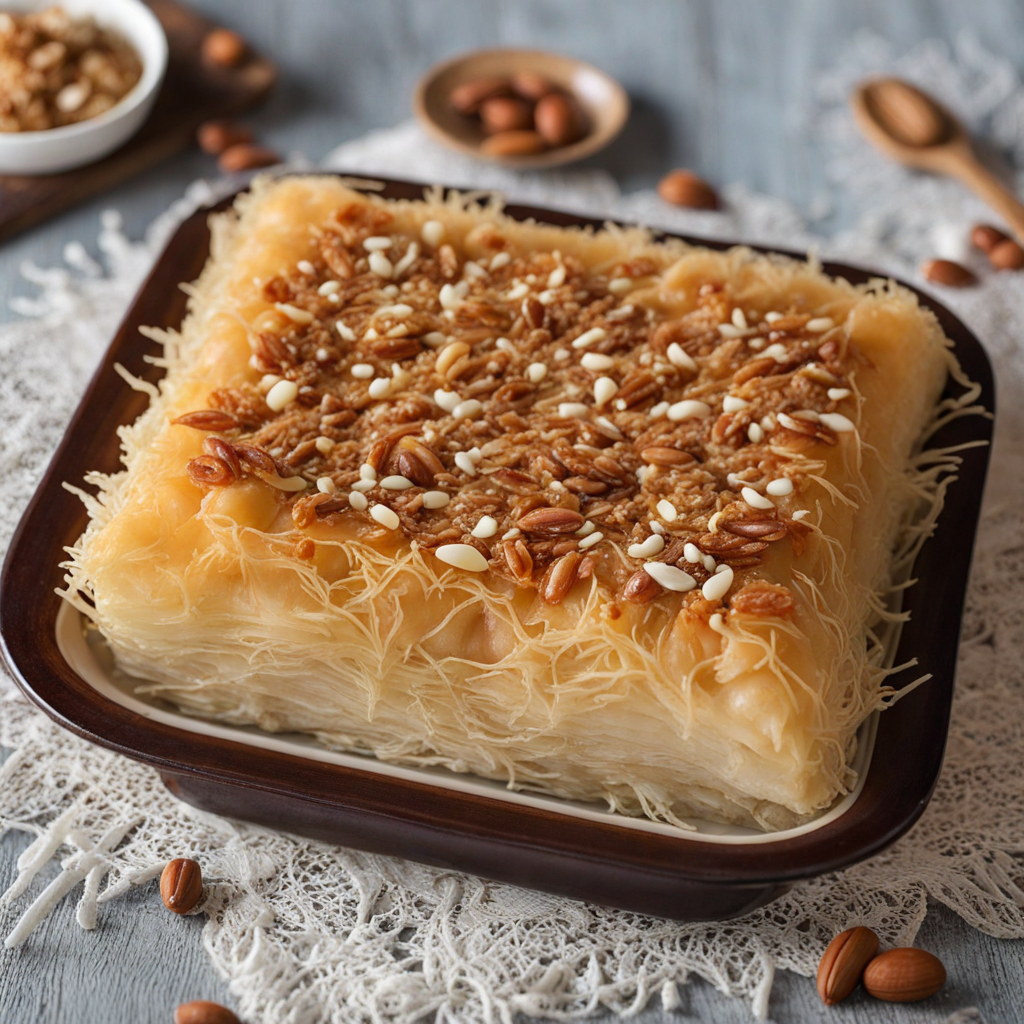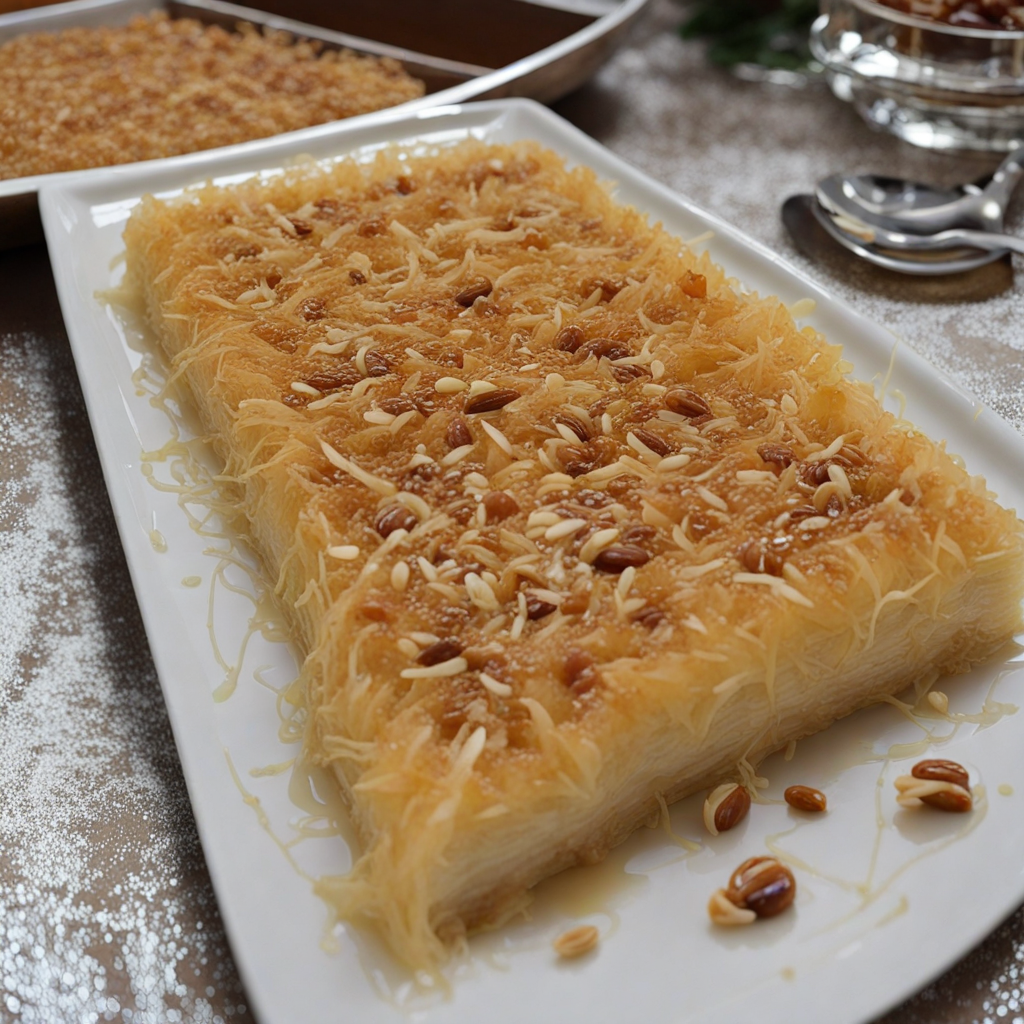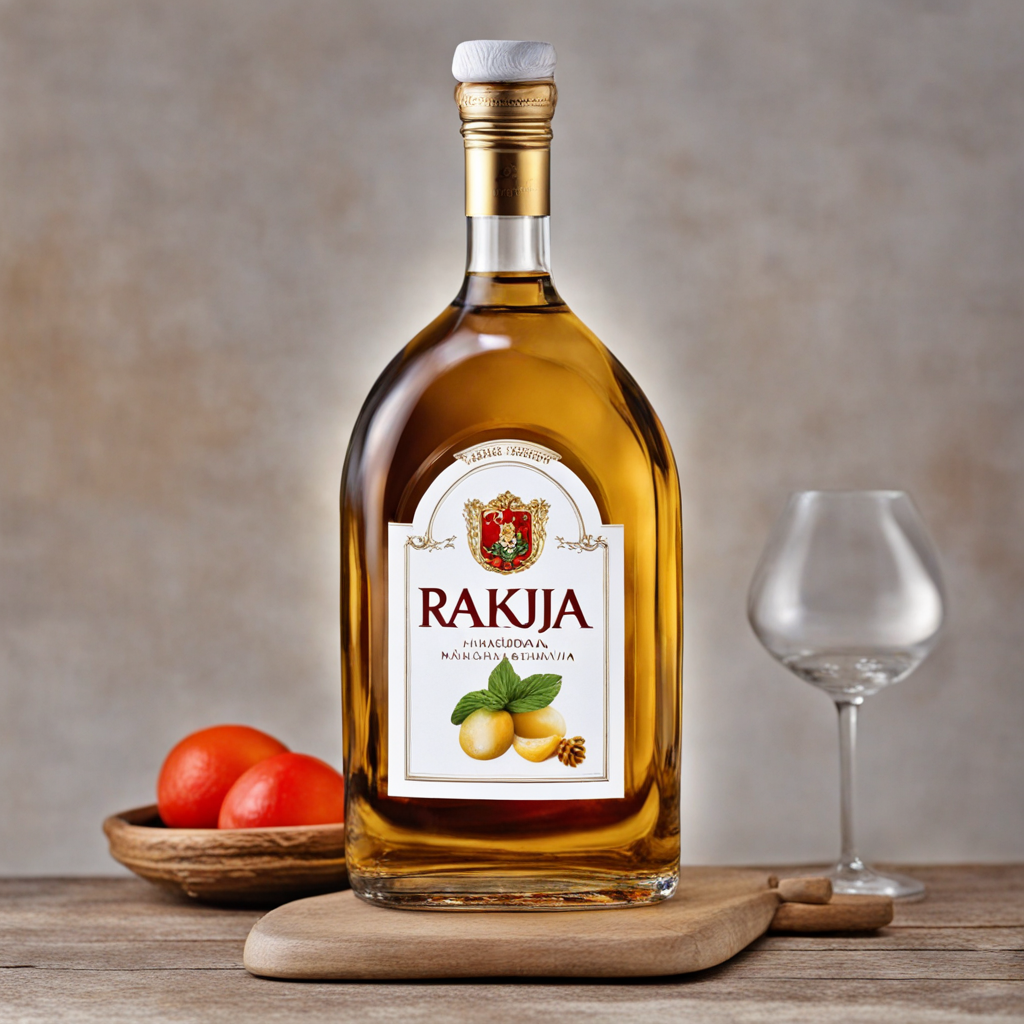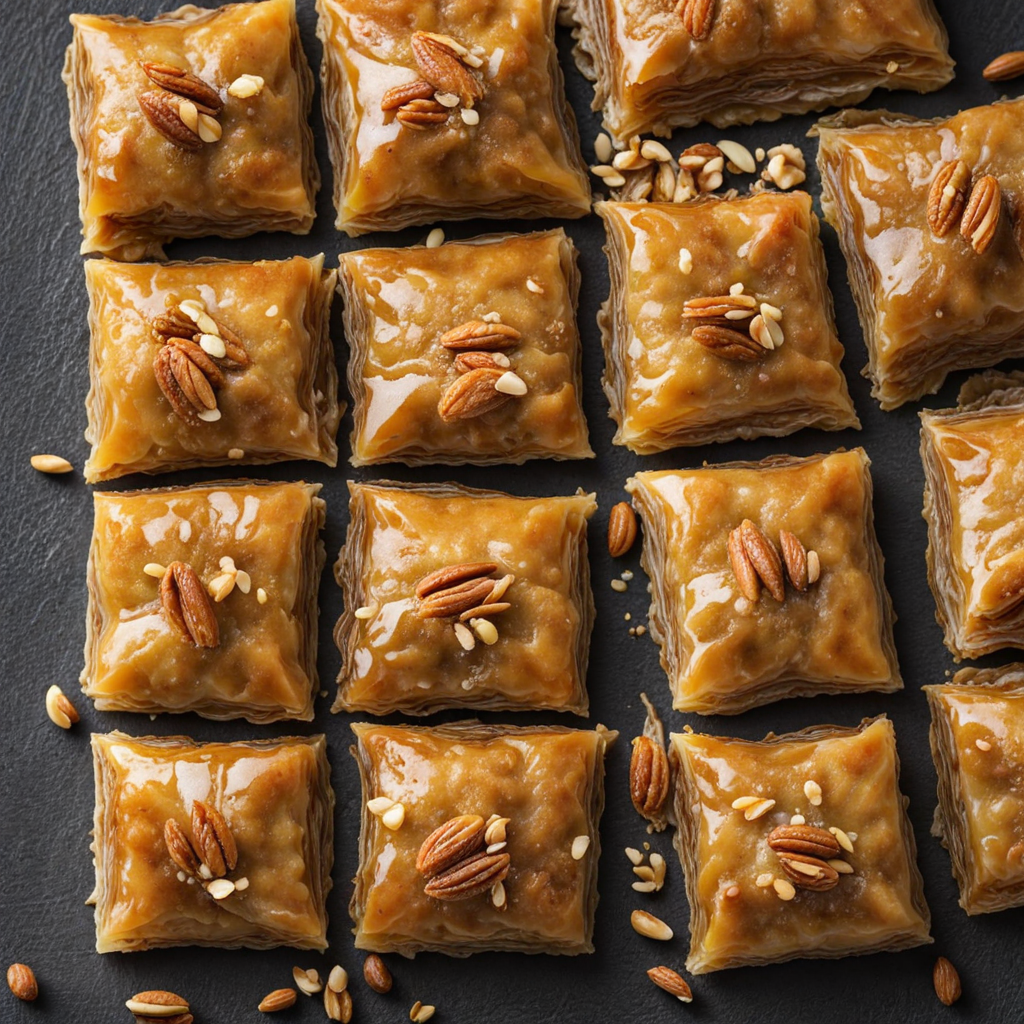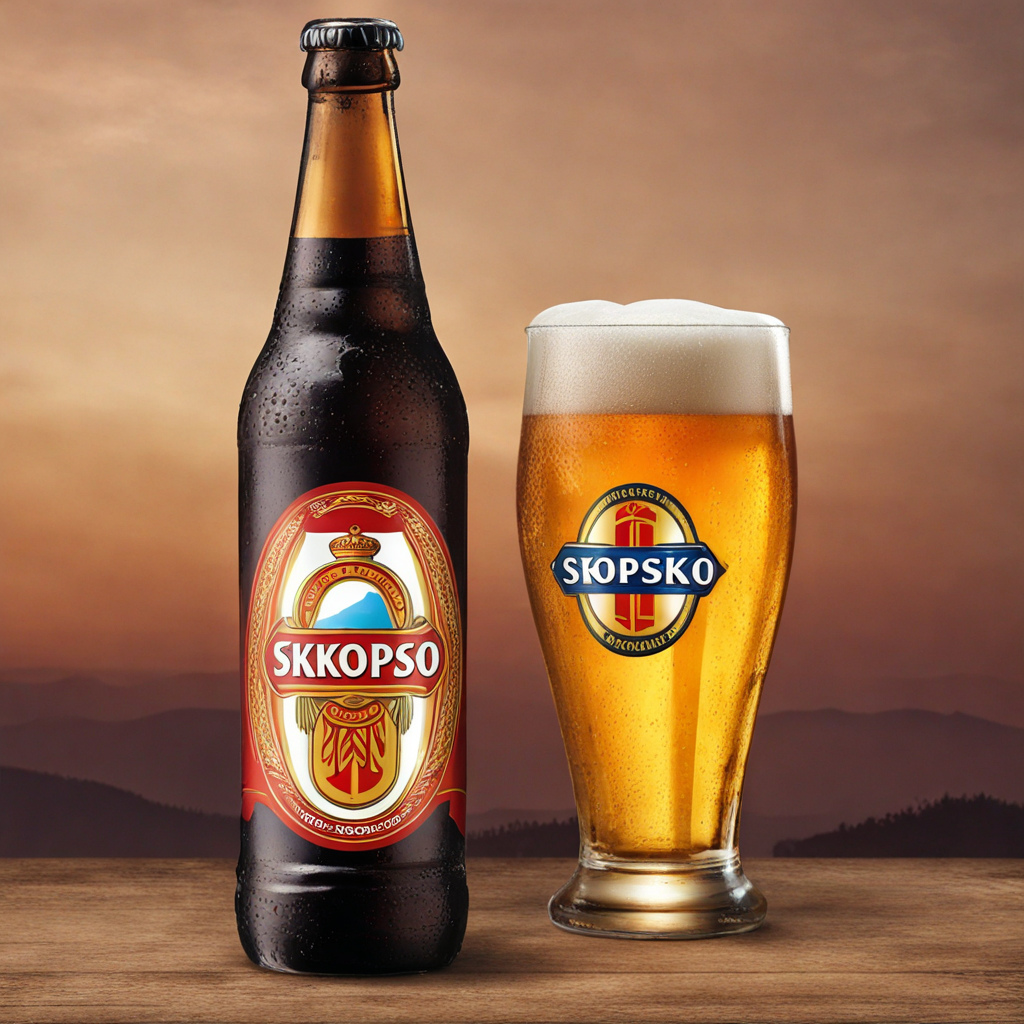Kadaif
Kadaif is a traditional dessert from North Macedonia that captures the essence of Middle Eastern and Balkan culinary influences. This sweet treat is made from thin, noodle-like strands of dough called kadaif, which are meticulously prepared to create a delicate and airy texture. The dough is typically layered with a generous filling of finely chopped nuts—often walnuts or pistachios—sweetened with sugar and flavored with cinnamon, adding a warm and aromatic depth to the dish. The combination of crunchy nuts and soft, syrup-soaked strands creates a delightful contrast that is both satisfying and indulgent. The preparation of kadaif involves a careful process of baking the layered strands until they reach a golden hue, after which a sweet syrup made from sugar and water, often infused with lemon juice or rose water, is poured over the warm pastry. This syrup seeps into the layers, making each bite irresistibly moist and flavorful. The result is a dessert that is not only visually appealing, with its intricate layers and golden topping, but also pleasing to the palate, with a harmonious balance of sweetness and nuttiness. Kadaif is often enjoyed during festive occasions and celebrations, making it a beloved staple in North Macedonian households. It can be served warm or at room temperature, and is usually cut into squares or diamond shapes for easy serving. Each piece offers a taste of tradition, bringing people together to share in the joy of this quintessentially Macedonian dessert. Whether you are a fan of Middle Eastern sweets or simply looking to explore new flavors, kadaif promises to delight your senses and leave you craving more.
How It Became This Dish
The History of Кадаиф: A Sweet Legacy from North Macedonia Origins and Early History Кадаиф, or kadaif, is a traditional dessert originating from the Middle East, with its roots deeply embedded in the Ottoman Empire's rich culinary landscape. While its precise origins are often debated, its presence in North Macedonia is a testament to the region's complex history of cultural exchange and influence. The dish is primarily made from thin strands of dough, resembling vermicelli, that are typically layered with a rich filling of nuts and sweetened with syrup. Historically, kadaif can be traced back to the ancient practice of making thin pastry, which was prevalent in various forms across the Mediterranean. The name "kadaif" comes from Arabic, where it denotes the fine strands of dough. As the Ottoman Empire expanded, so too did its culinary traditions, including the art of pastry-making. The dessert quickly became popular among the diverse cultures within the empire, adapting to local tastes and ingredients. Cultural Significance in North Macedonia In North Macedonia, kadaif is more than just a dessert; it is a symbol of hospitality, celebration, and tradition. The preparation of kadaif is often reserved for festive occasions such as weddings, religious holidays, and family gatherings. Its intricate preparation reflects the care and effort that hosts put into welcoming their guests, embodying the important Macedonian value of hospitality. Kadaif also holds a special place in the cultural narrative of the Macedonian people. The dish is often associated with the fusion of various culinary traditions, merging Ottoman influences with local ingredients and techniques. The use of nuts, particularly walnuts and almonds, along with the characteristic syrup made from sugar and water infused with lemon juice or rose water, highlights the blend of flavors that is central to Macedonian cuisine. Development Over Time The evolution of kadaif in North Macedonia can be seen as a microcosm of the region's tumultuous history. As the Ottoman Empire waned and the Balkan states emerged, the culinary traditions associated with kadaif began to adapt further. Local variations emerged, influenced by the availability of ingredients, regional tastes, and the influence of neighboring cultures. In the 19th and early 20th centuries, kadaif became associated with the growing sense of national identity among the Macedonian people. During this period, there was a resurgence in interest in traditional foods, reflecting a desire to reclaim and celebrate local heritage. Home cooks and pastry chefs began to experiment with variations of kadaif, often adding local twists such as the inclusion of seasonal fruits or different types of syrups. The post-World War II era marked another significant phase in the development of kadaif. As North Macedonia became part of the Socialist Federal Republic of Yugoslavia, culinary traditions were influenced by regional cooperation. Kadaif was shared across various Yugoslav republics, allowing for new interpretations and innovations. Each region brought its own flair, with some incorporating chocolate or cream into the filling, while others might add spices like cinnamon or cardamom for a distinctive flavor. The Modern Era: Revival and Popularity In the 21st century, kadaif has experienced a renaissance, particularly in North Macedonia, where it is often featured in both home kitchens and upscale restaurants. The modern culinary scene has embraced traditional foods, leading to a revival of interest in authentic recipes and techniques. Chefs are now experimenting with kadaif, pushing the boundaries of the dessert while still honoring its roots. Social media has played a significant role in this revival, with platforms like Instagram showcasing the beauty of kadaif to a broader audience. The visual appeal of the dessert, with its golden, crispy layers and glistening syrup, has made it a favorite among food enthusiasts and influencers alike. This exposure has not only increased local appreciation for the dish but has also attracted international interest, placing North Macedonian cuisine on the global culinary map. Kadaif in Contemporary Cuisine Today, kadaif is often served in various forms, from traditional to contemporary interpretations. Many households have their own cherished family recipes, passed down through generations, which often include unique fills or variations in syrup. Some have introduced modern twists, such as serving kadaif with a scoop of ice cream or pairing it with fresh fruits, creating a delightful contrast of textures and flavors. Moreover, the cultural significance of kadaif continues to be reinforced through community events and festivals dedicated to preserving and celebrating traditional foods. These gatherings provide opportunities for local cooks to share their techniques and recipes, ensuring that the heritage of kadaif is passed down to future generations. Conclusion: A Culinary Heritage Kadaif is more than just a dessert in North Macedonia; it is a rich tapestry of history, culture, and identity. Its origins are a reflection of the region's complex history, where diverse cultures have come together to create something uniquely beautiful and delicious. As it continues to evolve in modern kitchens, kadaif remains a poignant reminder of the importance of food as a vessel for cultural expression and community bonding. As North Macedonia embraces its culinary heritage, dishes like kadaif serve as a bridge connecting the past with the present, honoring traditions while inviting innovation. The sweet legacy of kadaif is a celebration of the region's history and an enduring symbol of hospitality, making it a cherished part of North Macedonian culture. Whether enjoyed at a festive gathering or savored at home, kadaif embodies the spirit of togetherness, inviting all to partake in its delightful sweetness.
You may like
Discover local flavors from North Macedonia


